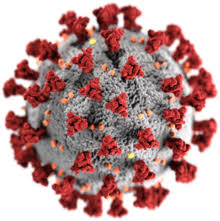BATOD survey summary – Members’ views on how COVID-19 and the lockdown had been affecting education and children’s services.

In May 2020 BATOD surveyed members to find out their views on how COVID-19 and the lockdown had been affecting education and children’s services. We asked about the impact on children and young people, their families, educational staff and wider society.
438 people responded. The majority worked in sensory support services followed by mainstream schools, special schools, resourced provision, independent schools and auditory implant services.
Colleagues who answered the survey described themselves as:
Qualified Teacher of the Deaf 79%
Teacher of the Deaf in training 7%
Educational Audiologist 7%
Educational Audiology Technician 1%
Allied Health Professional 2%
Other practitioner 4%
The first part of the survey invited free text responses from members on the following headings:
- Impact on deaf children and young people (CYP)
- Impact on families
- Impact on education settings
- Impact related to health and social care needs
- Impact on the profession
The second part of the survey invited responses to questions raised by the Education Select Committee inquiry. BATOD’s response to the Education Select Committee can be found at
https://www.batod.org.uk/about-us/batods-response-to-the-education-select-committee-enquiry/
What follows is a summary of the responses, including key themes. The final section of this document outlines some of the key actions BATOD is taking as a result of this survey.
BATOD would like to thank everyone for responding and sharing their experiences.
Italics indicates direct quotes from members.
- Impact on Deaf Children and Young People
Key themes:
- Relationship building
- Emotional well-being
- Access to resources
- Gaps in learning
A number of common challenges were identified for deaf children in being able to access remote learning; most of these related to:
- little or no differentiation of tasks and resources provided by mainstream schools
- families accessing online materials; for example, a lack of technology and/or technical knowledge needed for home learning
- limited accessibility for deaf children to online learning; in particular a lack of subtilties, not being able to lip-read when lessons were only available by audio and limited availability of materials and resources in British Sign Language
- the significant impact of the loss of face to face communication and the increased stress of working through screens and screen fatigue
- limited access to specialist support from Teachers of the Deaf and also communication support workers.
“Remote access is more challenging for deaf children when they have to rely on listening without the strategies they rely on every day, such as lipreading.”
The limited availability of audiological support was also raised by respondents. Issues highlighted included: reduced access to maintenance of hearing aids and cochlear implants, inconsistent use of amplification, poor fitting earmoulds, lack of access to health services and in particular the impact for newly identified deaf children and their families.
“For EY children and babies the impact may be seen longer term as a result of delayed referrals, difficulties in having conversations with families about their child’s hearing and impact on building relationships. Can make it harder to engage families with the support service.”
Respondents raised significant concerns about the negative impact for deaf children’s learning with the likelihood of an increased gap. It was also highlighted that very few deaf children had been accessing school be it because of the family situation (such as having a family member who is shielding), eligibility, parental choice or school availability (some school sites remained closed).
Deaf children and young people’s well-being and mental health was a primary concern too. Worries were expressed about the vulnerability of deaf CYP especially those with health needs. Isolation from peers and familiar support systems, as well as a loss of routine but also anxiety and lack of understanding about the pandemic were all cited as having a significant bearing.
“Social and emotional issues surrounding fear and lack of understanding of the virus, missing school and their friends and extended family. Inadequate technology – poor quality of phone signals/sound in place of video calls. Missing routine audiology and ENT appointments.”
In what has no doubt been a very challenging time respondents noted that there had been some positive outcomes such as:
- strengthened relationships with families.
- a more personalised approach to learning and more 1:1 support
- regular support being offered through a greater variety of means including:
video learning sessions, classes and groups, garden gate drop offs, and providing technology and audio equipment
- deaf CYP experiencing less fatigue due to not having the whole school day.
- Impact on Families
Key themes:
- Parents as teachers
- Isolation
- Access to services
The impact on families has been observed to be wide-ranging and diverse. The loss of contact with other families and support groups along with reduced professional support resulted in isolation for many. Some respondents reported that parents were anxious about loss of learning for their child and what this might mean for their future. However, this was not seen to be the case for all families as responses also included feedback as to how some families had “flourished” and had the opportunity to spend more time together.
“Some have benefited from spending more time with their children. They have been able to spend lots of quality time with their children and have enjoyed taking more of a role in their education. They have increased their knowledge and skills in some cases (one mum has been delighted to learn how to email for the first time; other families have begun to learn to sign through virtual signing lessons provided by our service).”
The suddenness of school closures and the lack of time for families, schools and services to prepare was raised as a key issue. Respondents commented that:
- for some families it was a struggle to engage children with their learning
- work provided by schools was not always sufficiently differentiated especially for families where children had additional needs or English as an additional language.
- there was limited support for families in terms of taking on the role of their CYP’s teacher and not all families have the communication skills e.g. in BSL/SSE to support curriculum delivery
- some families felt the additional pressure of ensuring hearing aids/specialist equipment was well maintained.
“Families have had to take on the role of teachers and this can be hard when deaf children do not understand why they cannot just play all day as they are at home.”
Concerns were also shared about families managing mental health issues and those facing financial difficulties, along with juggling working from home and supporting their child’s education, especially where children have additional needs or there are mental health needs.
“they [families] are subject to financial pressures, stresses of having to work from home whilst home schooling; many Deaf CYP have additional needs which may lead to need for shielding. Many Deaf CYP have limited language and understanding so explaining what is happening currently is very difficult.”
“Families where the adults have mental health issues are of a particular concern. Some families will have been brought closer together by this, but for families where there are tensions, poor communication or abuse this has been a very difficult time.”
“Some families have had a positive impact; they have learnt more about how their child learns curriculum activities and how to access the learning. Some families have struggled, particularly those with autism and deafness.”
“Some have felt very nervous; they’re reluctant to send their children back to school. Others are struggling with home schooling; they may have other children, including children with other disabilities. They welcome the contact with the Teachers of the Deaf and other specialist staff.”
The lack of access to medical services, assessments, appointments and delays in providing interventions and technology were all mentioned by respondents as bringing about challenges for families. In relation to hearing aids and cochlear implants the feedback was varied in that respondents noted some parents reporting improved usage, as they are at home with their child, whereas in other cases there were significant concerns about consistency of usage especially for early years children.
“The families of children who are recently diagnosed have missed out on early support, especially with getting started with amplification. Families going through the implant process have lost support and are trying to do their best, but it is so hard to assess progress and model what to do next, especially when families have their own access issues eg EAL.”
Respondents also shared examples of how schools and services had adapted to be able to support families maintaining regular contact including an increasing use of social media, online platforms and wider technology. Providing personalised support, guidance and resources was a key priority.
- Impact on Education Settings
Key themes:
- Lack of differentiation for deaf CYP
- Social distancing and the negative impact for deaf CYP
- Wellbeing
- Innovation and resources
The responses to the survey about the impact on education settings mainly centred around the difficulties schools faced in quickly having to move the curriculum online and providing remote learning as well as adapting the onsite provision. Lack of technology, online teaching with little or no training, as well as limited access to signing were key challenges raised.
A reoccurring theme throughout the survey was the lack of deaf awareness and differentiated materials, with schools finding it hard to meet all SEN needs.
“Staff have so much pressure on them in so many ways that low incidence needs like deafness can be overlooked.”
Respondents noted that QToDs had a vital role in supporting schools and families, acting as a bridge between them, and also providing personalised advice about the needs of individual deaf children.
“Some have been overwhelmed by the speed at which schools closed and have struggled to send work home that is the appropriate level for the child. Some schools have sent work to the ToD first to look at and suggest adaptations before sending home to ensure that the pupil can access the work.”
Whilst the issue of the lack of differentiation was a recurring theme, respondents also reported that people have found creative ways of working to ensure deaf children’s needs were met.
“Teachers are working extra to provide fantastic resources in a completely different way.”
Concerns were raised about the impact of social distancing measures on deaf children being able to have full access when in school such as: listening at a distance, use of facemasks, use of radio aids and not being able to learn incidentally and from peers.
“Social distancing is harder for deaf people – they have more difficulty hearing and lip-reading at a distance. They can’t lip-read through masks if others choose to wear them.”
“Solitary working in individual workstations and social distancing are all diametrically opposed to our normal working methods and this will take serious adjustment all round.”
“Staff are concerned about ability to explain social distancing to deaf children in their classes.”
In addition, there was also feedback about parents’ worries regarding their children attending school.
“Parents felt YP were less at risk at home and decided not to take up the option allowing vulnerable YP to attend school. Transport was and still is a real concern for parents going forward.”
- Impact Related to Health and Social Care Needs
Themes:
- Changes in service provision
- Engagement
The effects of the pandemic and subsequent lockdown resulted in significant changes to the provision of health and social care. Multi-agency working, good co-ordination and communication were seen to be essential in maintaining support for deaf CYP and their families. QToDs were identified as having a key role in this.
“Access to services reduced . . . all understandable when services are having to be prioritised and staff and patient safety considered. Good communication remains, enabling confidence in services to continue.”
With regards to health, respondents focused on audiology provision and referred to delays with assessments, earmould provision, cochlear implant surgery and mapping as well as hearing aid fine tuning. There was reference to the fact that services have had to prioritise and that this will lead to a backlog. However, examples were also shared of how services had adapted and continued to provide a continuity of care. The issue of hospital appointments was also raised in terms of parental anxiety around attending appointments as well as the impact PPE (especially facemasks) has on deaf CYP’s access.
“I think families have felt they’ve needed to struggle on sometimes. Services have been really good at sending out spares and repairs.”
“Our audiology department has been really good with sending out batteries, tubing, triaging problems when they have come to light via ToD remote sessions. Parents are anxious, though, of going into clinical settings for new earmoulds.”
Safeguarding and support from social care was also mentioned in a number of responses.
“Safeguarding processes are still being followed, and social workers carrying on being involved. However, many families don’t have the resources to enable their children to thrive in the current situation.”
“Early Help, CAMHS assessment team and children’s safeguarding have continued to function during lockdown and this has included some home visits and regular telephone calls to families.”
“Been good work relationship between social care and education when safeguarding issues have been raised. Health harder as many have been redeployed but audiology always helpful when been called on.”
“Pupils with social workers and particularly challenging situations have been coming into school throughout this. We have also continued with psychotherapy sessions via the interpreters and play therapy sessions by video and conversations with parents by phone. The speech and language therapy work has continued in the same way and parents have been supported with games and work and activities to support particular issues of speech and language.”
Some respondents reported that there has been a greater strain on accessing social care including a reduced service from CAMHS. It was also highlighted that deaf CYP may be less able to access support, due to language and communication needs, such as Childline, NSPCC, etc.
“Some students were using counselling services and now they don’t have access to these. They are at home ‘coping’. Parents feel isolated.”
- Impact on QToDs/ToDs/Deaf teachers
Themes:
- Greater creativity and resourcefulness
- Partnership working
- Use of technology and online platforms
- Professional development
Working flexibly and creatively was a common theme in the responses. The QToD profession has adapted with dedication and determination to the wide range of challenges which have arisen as a result of the pandemic.
“I think we are stronger, more resourceful and creative.”
There were many examples of how respondents had found resourceful ways to continue to support deaf CYP and their families. Live-teaching sessions using remote platforms, pre-recorded videos, posting resources, setting-up online groups and delivering learning physically via social distancing visits were some examples given of the range of services offered.
“It has shown how adaptable and creative we are: finding new ways of working and supporting. Families have really appreciated the email/phone/text support and resources we are making and sending out. Continued flexibility from employers as many ToDs are carers/home schooling children at the same time as continuing to work.”
“Profession has adapted and is constantly developing new ways of working with other staff and young people.”
“We have become more skilled in IT and in finding different ways of working with children and families.”
Respondents also commented on how it had been possible to build and sustain relationships with families, “… the contact with parents has increased which is positive and it is more vital than ever that we play an advisory role for school staff, especially being more creative in how to do training in the future.”
However, concerns about both the short and long-term impact of the lack of direct QToD face to face support for CYP and their families was a core concern. As one respondent noted: “it’s difficult to give the same level of input via online platforms.” In addition, some respondents were worried that remote working with families may be seen to be able to replace direct contact.
“In some ways this has given us the opportunity to look at how we provide support and services and find new ways to connect. I think there needs to be more opportunity to train and build confidence in new ways of working.”
There were many responses showing examples of partnership working with mainstream schools. Providing specialist advice to SENCOs and teachers as well as continuing to contribute to Education, Health and Care Plans (EHCPs) (in England) and Annual Reviews.
“I have formed much closer relationships with families over this period which has been positive. Mainstream settings have appreciated input and support from us as they seek to support the families for deaf CYP. Joint working with other professionals has been strengthened as we all work together for positive outcomes.”
For some respondents there had been personal challenges with balancing their home life (such as caring for children and relatives) and work commitments. Isolation was also referred to with some respondents feeling isolated from their teams and missing the direct work with families and their colleagues. In addition, some respondents felt that they did not have access to the technology and resources they needed in order to work effectively from home.
“It has been challenging to maintain contact with a large isolated team. Much of the advisory work can continue remotely and ToDs have been very resourceful. The positive is that it has allowed time for creativity and the development of some fantastic ideas we wouldn’t normally have time for.”
Some QToDs were limited by their employer’s regulations regarding using technology, software and online platforms such as Skype or Zoom. This was seen to raise a number of issues including lack of parity for families around the provision of service.
With the increased use of technology, the need for further professional development, especially regarding video interactions/tele-practice, was raised as a priority. With respondents commenting on having to become skilled in this very quickly and also the need for continuing professional development.
“The impact I believe is that the Teacher of the Deaf profession has had to quickly learn to become a virtual and online teacher. More training in virtual/online lessons would lessen the impact.”
Partnership working, sharing of information and resources across the profession and support from organisations such as BATOD, NDCS and NatSIP were particularly valued.
“The support from organisations such as BATOD, NatSIP, NDCS etc has been much appreciated!”
Wider issues were raised including the impact on trainee ToDs especially with regards to not being able to complete placements. As well as the possibility of a ‘new balance’ of remote working and face to face work.
“Workload/caseload feels challenging to manage at times as there has been a shift in attention. Less work can be done directly with the children and more wellbeing checks have had to take place with the family in general. Once some form of normality resumes, there will be a surge in new cases/diagnosis coming at once, which is likely to put a strain on some areas. Especially as additional time may need to be placed on higher input children’s development and access under the new and changing circumstances in schools. Positively – some aspects of working remotely could continue, allowing for some time to be freed to conduct more visits/allow for more liaison, potentially.”
“Personally, I think it has made me a better practitioner by adapting and adjusting to the challenges. I’ve learnt a lot about myself and built up a stronger relationship with parents and professionals.”
What is BATOD doing?
The positives and also the concerns raised by BATOD members through the responses to the survey along with our ongoing work have led to the identification of some key actions for the Association. BATOD, in partnership with the NDCS, has increased liaison with the Trade Unions to ensure the needs of deaf CYP are understood and considered when giving advice to their members and negotiating with Government. Many BATOD members are also members of the teaching unions and BATOD is keen to ensure the QToD profession/specialist support services are recognised and represented in their interaction with the DfE as well as their on-going support of the teaching profession. This fits with the overarching aim of BATOD – to advance the status of Teachers of the Deaf.
BATOD has again worked closely with the NDCS and NatSIP to develop guidelines for QToDs when returning to work in schools/homes to support safe working practices. BATOD also pledges to support the development of bespoke training to support the profession with using online learning platforms and technology overall. This will involve a review of online platforms when considering their future use from the perspectives of deaf CYP, the families and specialist staff. Another of BATOD’s aims is to ensure and enhance the high quality of mandatory training of Teachers of the Deaf and their continuing professional development and the BATOD website has provided a wealth of information since the onset of the Covid crisis, with many QToDs demonstrating their professional generosity through sharing ideas and resources.
BATOD has been working with the NDCS to campaign for the provision of clear face masks which can be used in wider society but also in health settings.
One of the main aims of BATOD is to support the profession in relation to promoting the education of all deaf children, young persons and adults. The need for face to face working with deaf CYP remains an essential part of the QToD role.
Steph Halder
BATOD President
2018 – 2021
NB: In relation to PPE BATOD recommends education providers follow guidance from Public Health England and equivalent bodies in the other nations and seek advice from their local authority and organisation which provides support with regards to infection control. Government guidance is that face coverings are not required in education settings. Should the recommendation change, it is essential that masks/face coverings which enable lipreading are used in education settings and also beyond.





